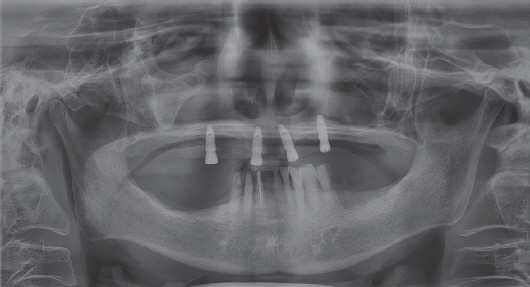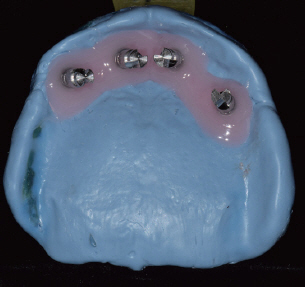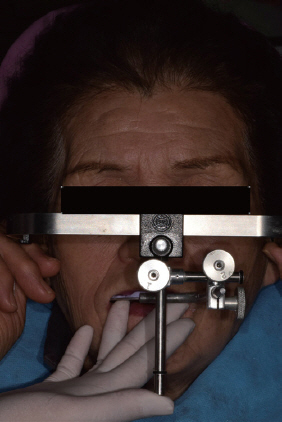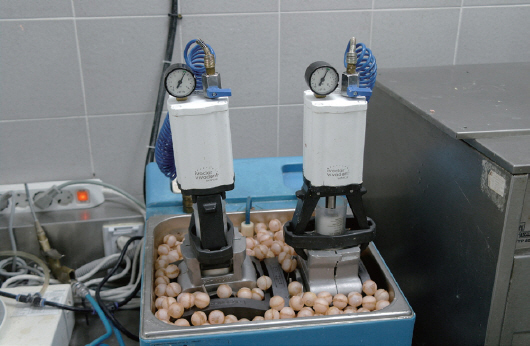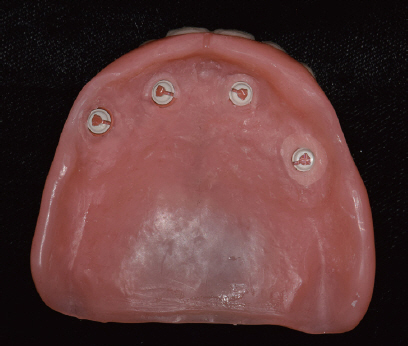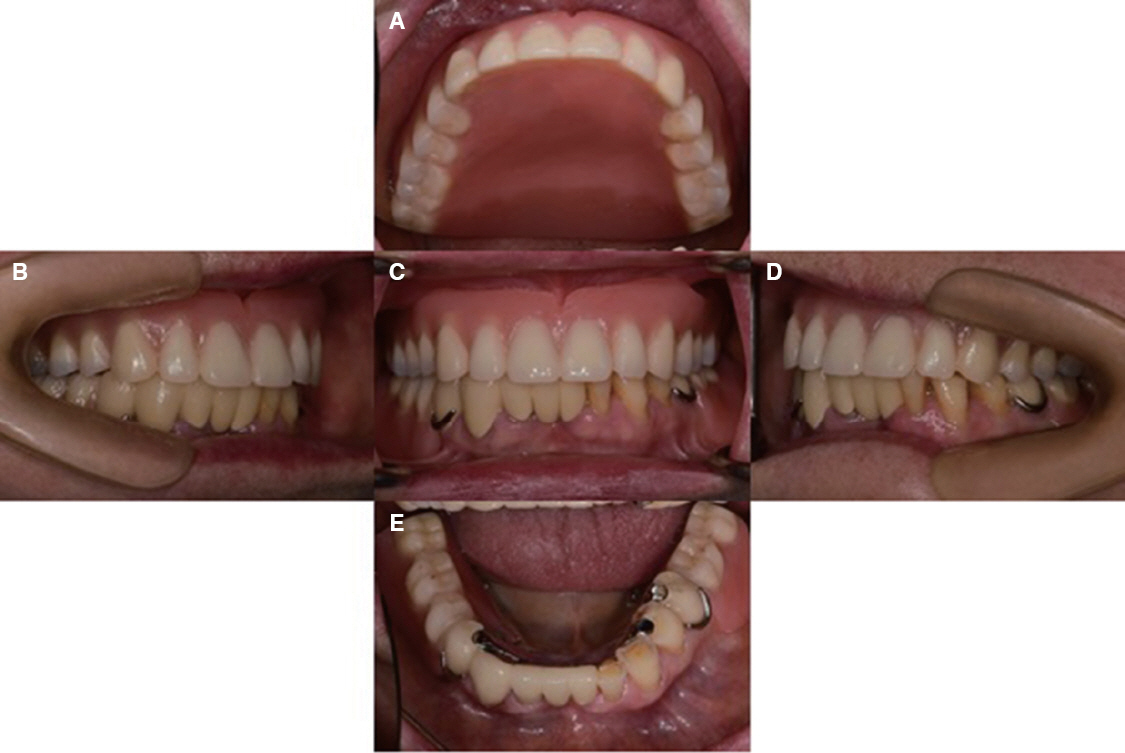J Dent Rehabil Appl Sci.
2017 Dec;33(4):321-328. 10.14368/jdras.2017.33.4.321.
Implant-retained overdenture with CM LOC ® Pekkton® in maxillary edentulous patient
- Affiliations
-
- 1Department of Prosthodontics, College of Dentistry, Dankook University, Cheonan, Republic of Korea. syshin@dankook.ac.kr
- KMID: 2405546
- DOI: http://doi.org/10.14368/jdras.2017.33.4.321
Abstract
- Treatment options for edentulous patients are complete denture and implant prosthesis. A two implant-retained overdenture can be considered the first treatment in the edentulous mandible, but there is no clear consensus of treatment for edentulous maxilla. Implant-retention/support overdenture shows better retention and stability than complete denture and is less expensive and more esthetic than implant-supported fixed prosthesis. CM LOC® Pekkton® attachment is a solitary type attachment and evaluated to have excellent abrasion resistance and retention with a female part made of poly-ether-ketone-ketone. Meanwhile, SR Ivocap system is injection molding method and discussed to show few changes in the vertical dimension of denture and have excellent fracture resistance. In this case, we restored maxillary arch with a four implant-retained overdenture using CM LOC® Pekkton® and SR Ivocap system, and mandibular arch with a removable partial denture. Through this procedure, satisfactory outcomes were achieved both in functional and esthetic aspects.
Keyword
MeSH Terms
Figure
Reference
-
References
1. DeBoer J. Edentulous implants: overdenture versus fixed. J Prosthet Dent. 1993; 69:386–90. DOI: 10.1016/0022-3913(93)90186-R.2. Feine JS, Carlsson GE, Awad MA, Chehade A, Duncan WJ, Gizani S, Head T, Lund JP, MacEntee M, Mericske-Stern R, Mojon P, Morais J, Naert I, Payne AG, Penrod J, Stoker GT Jr, Tawse-Smith A, Taylor TD, Thomason JM, Thomson WM, Wismeijer D. The McGill Consensus Statement on Overdentures Montreal, Quebec, Canada. May 2425 2002. Int J Prosthodont. 2002; 15:413–4. PMID: 12170858.3. Ekfeldt A, Johansson LA, Isaksson S. Implant-supported overdenture therapy: a retrospective study. Int J Prosthodont. 1997; 10:366–74. PMID: 9484047.4. Parel SM, Phillips WR. A risk assessment treatment planning protocol for the four implant immediately loaded maxilla: preliminary findings. J Prosthet Dent. 2011; 106:359–66. DOI: 10.1016/S0022-3913(11)60147-9.5. Chan MF, Närhi TO, de Baat C, Kalk W. Treatment of the atrophic edentulous maxilla with implantsupported overdentures: a review of the literature. Int J Prosthodont. 1998; 11:7–15. PMID: 9588985.6. Trakas T, Michalakis K, Kang K, Hirayama H. Attachment systems for implant retained overdentures: a literature review. Implant Dent. 2006; 15:2434. DOI: 10.1097/01.id.0000202419.21665.36. PMID: 16569958.7. Passia N, Ghazal M, Kern M. Long-term retention behaviour of resin matrix attachment systems for overdentures. J Mech Behav Biomed Mater. 2016; 57:88–94. DOI: 10.1016/j.jmbbm.2015.11.038. PMID: 26705935.8. El Bahra S, Ludwig K, Samran A, Freitag-Wolf S, Kern M. Linear and volumetric dimensional changes of injection-molded PMMA denture base resins. Dent Mater. 2013; 29:1091–7. DOI: 10.1016/j.dental.2013.07.020. PMID: 24001949.9. Strohaver RA. Comparison of changes in vertical dimension between compression and injection molded complete dentures. J Prosthet Dent. 1989; 62:716–8. DOI: 10.1016/0022-3913(89)90599-4.10. Gharechahi J, Asadzadeh N, Shahabian F, Gharechahi M. Dimensional changes of acrylic resin denture bases: conventional versus injectionmolding technique. J Dent (Tehran). 2014; 11:398405.11. Uzun G, Hersek N. Comparison of the fracture resistance of six denture base acrylic resins. J Biomater Appl. 2002; 17:19–29. DOI: 10.1177/0885328202017001597. PMID: 12222755.12. Mericske-Stern RD, Taylor TD, Belser U. Management of the edentulous patient. Clin Oral Implants Res. 2000; 11:108–25. DOI: 10.1034/j.1600-0501.2000.011S1108.x. PMID: 11168261.13. Zou D, Wu Y, Huang W, Wang F, Wang S, Zhang Z, Zhang Z. A 3-year prospective clinical study of telescopic crown, bar, and locator attachments for removable four implant-supported maxillary overdentures. Int J Prosthodont. 2013; 26:566–73. DOI: 10.11607/ijp.3485. PMID: 24179972.14. Närhi TO, Hevinga M, Voorsmit RA, Kalk W. Maxillary overdentures retained by splinted and un-splinted implants: a retrospective study. Int J Oral Maxillofac Implants. 2001; 16:259–66. PMID: 11324214.15. Nissan J, Oz-Ari B, Gross O, Ghelfan O, Chaushu G. Long-term prosthetic aftercare of direct vs. indirect attachment incorporation techniques to mandibular implant-supported overdenture. Clin Oral Implants Res. 2011; 22:627–30. DOI: 10.1111/j.1600-0501.2010.02026.x. PMID: 21070382.16. Whang SW, Chung MK. Comparative tensile bond strength of heat-cured, cold-cured, and light cured denture base resins bonded to continuous-pressure injection type denture base resin. J Korean Acad Prosthodont. 1993; 31:385–93.
- Full Text Links
- Actions
-
Cited
- CITED
-
- Close
- Share
- Similar articles
-
- The Implant Retained Overdenture by Locator Attachments on the Edentulous Mandible: A Case Report
- Fabrication of maxillary complete denture and mandibular implant retained overdenture using CAD-CAM system and Monolithic disc: a case report
- Finite element stress analysis of maxillary two implants-retained overdenture according go position of implant fixtures
- Implant-assisted overdenture using milled bar and ADDTOC in edentulous maxilla: A case report
- Finite element analysis on stress distribution of maxillary implant-retained overdentures depending on the Bar attachment design and palatal coverage



